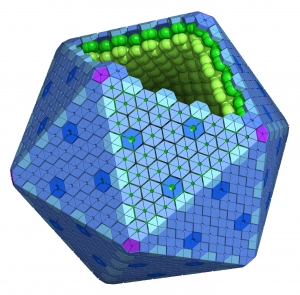DOI: 10.1104/pp.113.232611
Can the cyanobacterial carbon-concentrating mechanism increase photosynthesis in crop species? A theoretical analysis.
Abstract

Experimental elevation of [CO2] around C3 crops in the field has been shown to increase yields by suppressing the Rubisco oxygenase reaction and, in turn, photorespiration. Bioengineering a cyanobacterial carbon-concentrating mechanism (CCM) into C3 crop species provides a potential means of elevating [CO2] at Rubisco, thereby decreasing photorespiration and increasing photosynthetic efficiency and yield. The cyanobacterial CCM is an attractive alternative relative to other CCMs, because its features do not require anatomical changes to leaf tissue. However, the potential benefits of engineering the entire CCM into a C3 leaf are unexamined. Here, a CO2 and HCO3− diffusion-reaction model is developed to examine how components of the cyanobacterial CCM affect leaf light-saturated CO2 uptake (Asat) and to determine whether a different Rubisco isoform would perform better in a leaf with a cyanobacterial CCM. The results show that the addition of carboxysomes without other CCM components substantially decreases Asat and that the best first step is the addition of HCO3− transporters, as a single HCO3− transporter increased modeled Asat by 9%. Addition of all major CCM components increased Asat from 24 to 38 µmol m−2s−1. Several Rubisco isoforms were compared in the model, and increasing ribulose bisphosphate regeneration rate will allow for further improvements by using a Rubisco isoform adapted to high [CO2]. Results from field studies that artificially raise [CO2] suggest that this 60% increase in Asat could result in a 36% to 60% increase in yield.
